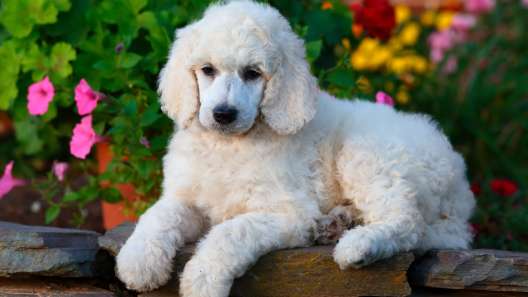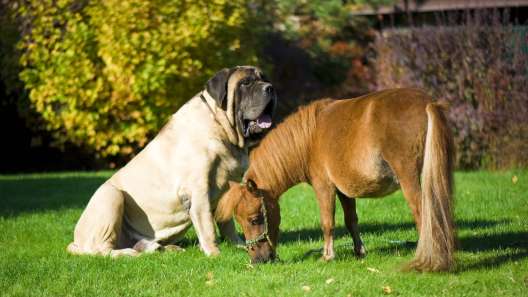
-
Activity Level:
moderate
-
Shedding Level:
low
-
Grooming Level:
moderate
-
Trainability:
high
-
Good for Novice Owners:
high
-
Adaptability:
moderate
-
Kid/Pet Friendly:
often
-
Prey Drive:
low
-
Watchdog:
aware
- Average Size: Giant
- Average Lifespan: 11-13 years
- Registered?: other
Saint Berdoodle Dog Breed Information
Overview
Temperament
Adaptability
Health
Owner Experience
Grooming
Activity Level
Size
Life Span
Did You Know?
The Saint Berdoodle is a cross between a Saint Bernard and a Standard Poodle. Although a mixed-breed dog can take on any combination of traits from one or both of their parent breeds, well-socialized Saint Berdoodles tend to be affectionate and loving dogs with sweet natures and social personalities.
This designer dog breed may not be recognized by the American Kennel Club, but they are still recognized by other notable dog organizations. The Saint Berdoodle is recognized by the American Canine Hybrid Club, the Designer Breed Registry, the Designer Dogs Kennel Club, and more.
The Saint Berdoodle is a gentle giant that makes a great addition to any family. Well-socialized, they tend to be social and friendly with charming, cheerful personalities. They also tend to be affectionate, loving, and highly intelligent dogs. With some of the most kid-friendly dog breeds as parents, it’s no wonder that the Saint Berdoodle tends to get along well with children, other dogs, and other pets.
These dogs can be good watchdogs as they are initially wary of strangers and will alert you when someone is on the property. It’s not a bad idea to start training your dog to stop barking early on to keep it to alerting and to keep it from becoming a nuisance. Although Saint Berdoodles do tend to have a protective instinct over their family and territory, they tend to be quite social and friendly and do not tend to be aggressive provided they have been properly socialized and trained.
Saint Berdoodles are moderately adaptable dogs. Due to their sheer size, they are better suited to larger homes with yards where they can run and roam freely. They could potentially adapt to apartment living if they are given enough exercise, attention, and mental stimulation, but their size will definitely be a challenge in smaller spaces.
This dog adapts well to most moderate climates. Although they have a fluffy coat and tend to prefer cooler weather, they are not a typical snow dog breed and aren’t built for very cold temperatures. As a large, fluffy dog, they are also sensitive to heat and can easily overheat. Because a Saint Berdoodle craves attention, bonds closely with their family, and loves being with them, they do not like to be left alone for long periods of time.
A crossbred dog can inherit the potential health concerns common to one, both, or neither of the parent breeds. Potential health concerns to be aware of in Saint Berdoodles can include ear infections, hip dysplasia, elbow dysplasia, skin problems, Von Willebrand’s Disease, and Wobbler Syndrome. Good breeding practices make a big difference in the health of Saint Berdoodle puppies.
Reputable breeders will screen their dogs to ensure that they are not passing preventable issues to puppies. Make sure you ask the breeder about the genetic history of both of the parents. You can also ask about any health tests or clearances that have been done.
As a large dog, the Saint Berdoodle is also at a higher risk of bloat just like both parent breeds. Bloat in dogs can become dangerous quickly and is fatal if the stomach flips. It’s important to know what you can do to help reduce the risk and the signs and symptoms associated with it, so you know when to get to the emergency vet.
Although the Saint Berdoodle will grow to be a giant dog, they tend to be gentle and highly trainable. Their high intelligence and eagerness to please means they pick up on things quickly and are relatively easy to train. This makes them a good fit for owners of all experience levels.
They respond best to positive training methods that are calm and consistent and focused on reward and praise. These are useful techniques for teaching basic commands and also for training your dog not to jump up, which is a good idea for puppies that will grow into big dogs.
Puppy training classes are always an option and can be a good opportunity to socialize a puppy, which is even more important in a dog this size. And, because Saint Berdoodles will grow into very big dogs, it’s a good idea to start leash training early.
The maintenance your Saint Berdoodle requires will depend completely on the coat they inherit. If they inherit more of a Poodle coat, they will be non/low-shedding. But, they will require daily brushing and professional grooming every 4-6 weeks. If they inherit more of a Saint Bernard coat, they’ll shed moderately and more heavily when the seasons change, need brushing a few times a week, and require an occasional bath as needed.
Regardless of their coat type, you will need to care for your Saint Berdoodle’s nails, ears, and teeth. Once or twice monthly nail trimming is usually enough to keep them from growing too long and causing issues. But, if nails aren’t wearing down as much naturally, or they just grow fast, you may need to cut your dog’s nails more often.
Checking and carefully cleaning your dog’s ears weekly as needed can help prevent ear infections. Brushing your dog’s teeth or using an enzyme toothpaste every day, in addition to cleanings at the vet when needed, is the ideal foundation for good dental care for dogs. You can also support your efforts to prevent dental diseases later in life with dental hygiene chews and treats approved by your vet.
Thankfully, the Saint Berdoodle’s energy level does not match their size. Saint Berdoodles tend to have a moderate energy level. They will be energetic while playing and require some exercise, but they will be happy to be a couch potato every now and then.
Daily walks plus some time to play are usually enough for this big dog. They may not be a good fit for a running partner, but your Saint Berdoodle may enjoy going on hikes with you, taking trips to the dog park, or even going swimming. Just make sure you keep activities low impact until their bones and joints finish growing and developing.
A fully-grown Saint Berdoodle usually stands 24-30 inches tall at the shoulder and weighs 110-200 pounds. They are one of the largest dog breeds.
Saint Berdoodles generally live for 11-13 years on average.
This designer dog breed is most commonly known as a Saint Berdoodle, but they are also sometimes called a Saint Berpoo.








